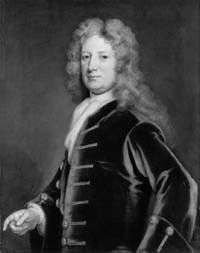Thomas Wharton, 1st Marquess of Wharton

Thomas Wharton, 1st Marquess of Wharton PC (August 1648 – 12 April 1715) was an English nobleman and politician. A man of great charm and political ability, he was also notorious for his debauched lifestyle.
Background
He was the son of Philip Wharton, 4th Baron Wharton and his second wife, Jane Goodwin, only daughter of Colonel Arthur Goodwin of Upper Winchendon, Buckinghamshire, and heiress to the extensive Goodwin estates in Buckinghamshire, including Winchendon, Wooburn, Waddeston, Weston, and other properties.[1]
Career
In his long political career he was a Member of Parliament for seventeen years[2] and spearheaded the Whig opposition to King James II's government, which later developed the two party political system under Queen Anne. Before the Glorious Revolution he was in close contact with a group of army officers conspiring against King James, including his brother Captain Henry Wharton.
In 1689 he was sworn of the Privy Council and made Comptroller of the Household by King William III, establishing the link between the royal position and government for the first time, although William is said to have distrusted him.
He went out of office in 1702, after the accession of Anne (who disliked him intensely, and took great pleasure in personally taking his staff of office from him),[3] but in 1706, he was created Earl of Wharton and Viscount Winchendon in the Peerage of England. He served as Lord Lieutenant of Ireland 1708–1710.[4]
Character and scandals
Anne's dislike of him was partly the product of her dislike for the Whig Junto- the "five tyrannising lords", which William III had shared to some extent,[5] but far more to his debauched and irreligious character. Even by the standards of Restoration rakes, Wharton was considered a man "void of moral or religious principles".[6] The most striking charge was that in 1682, when drunk, he had broken into the church in Great Barrington, Gloucestershire, and relieved himself against the communion table and in the pulpit.[7] The story is probably true: certainly in 1705 during a debate on Church matters in the House of Lords Wharton was left speechless when Thomas Osborne, 1st Duke of Leeds directly accused him of it.[8]
Despite his faults he has been described as a man of immense charm, a fine public speaker and a "political organiser of genius".[9] As the dominant politician in Aylesbury, he was partly responsible for the landmark constitutional case of Ashby v White, which established the principle for every wrong there is a remedy.
It is rumored that Wharton had taken Dorothy Townshend, née Walpole, as a lover prior to her marriage. It is possible there is some truth to this as further rumors suggest that her later husband, Charles Townshend, 2nd Viscount Townshend may have either killed her or faked her funeral and hid her away at Raynham Hall. This rumor is based on the alleged infidelity of Dorothy during their marriage.[10] She is also rumored to haunt Raynham, known as the Brown Lady of Raynham Hall.
Last years
Under George I of England, he returned to favour. In January 1715, he was created Marquess of Catherlough, Earl of Rathfarnham, and Baron Trim in the Peerage of Ireland, and in February 1715 Marquess of Wharton and Marquess of Malmesbury in the Peerage of Great Britain.
When he died in April 1715 he was buried in Upper Winchendon, Buckinghamshire. He is generally credited as author of the original lyrics of Lillibullero, which "rhymed King James out of England".
Family
Wharton married firstly on 16 September 1673 Anne, or Nan, Lee (d 29 October 1685 aged 26), younger daughter of Sir Henry Lee, 3rd Bt. (d. 1659), an elder half-brother of the famous libertine poet John Wilmot, 2nd Earl of Rochester; she had some reputation as a poet and dramatist. They had no issue together. Her sister Eleanora Lee married James Bertie, Lord Norreys; their cousin was Edward Lee, 1st Earl of Lichfield. Although her husband had infected her with syphilis, Anne Wharton left him her fortune. Her grandmother Anne St. John, Countess of Rochester tried to regain her fortune from the Whartons with little effect.[11]
He married secondly Lucy Loftus, only daughter and heiress of Adam Loftus, 1st Viscount Lisburne.[12] They had one son Philip Wharton, 1st Duke of Wharton, and two daughters, Lucy Holt and Jane Morice.[13] On his son's death without heirs, all his titles became extinct, except the Barony which passed to Jane Morice.
See also
References
- ↑ Clark, J. Kent (2004).Whig's Progress: Tom Wharton between Revolutions, p.13. Fairleigh Dickinson University Press, Madison, N.J. ISBN 0-8386-3997-6.
- ↑ History of Parliament Online - Wharton, Hon, Thomas
- ↑ Kenyon, J.P. The Stuarts Fontana Edition 1966 p.188
- ↑ Rachel Wilson, ‘The Vicereines of Ireland and the Transformation of the Dublin Court, c. 1703-1737’ in The Court Historian, xix, no. 1 (2014).
- ↑ Kenyon p.188
- ↑ Somerset, Anne Queen Anne Harper Press 2012 p.197
- ↑ Somerset p.197
- ↑ Somerset p.294
- ↑ Kenyon, J.P. Robert Spencer, 2nd Earl of Sunderland 1641-1702 Longmans Green and Co. 1958 p. 270
- ↑ http://historiesofthingstocome.blogspot.com/2011_10_16_archive.html
- ↑ James William Johnson. "My dearest sonne": Letters from the Countess of Rochester to the Earl of Lichfield University of Rochester Library Bulletin Volume XXVIII · Number 1 · Summer 1974
- ↑ Mosley, ed. Burke's Peerage 107th Edition 2003 Vol.1 p.899
- ↑ Mosley p.899
|